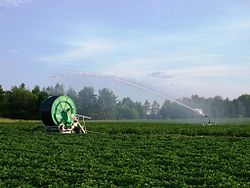Irrigation techniques
Contenido keyboard_arrow_down
The irrigation techniques are divided into traditional or non-traditional.
Shallow
The traditional irrigation technique is surface irrigation.
This system in turn has three modalities:
- Flood (also called manta irrigation or foot irrigation), which is mainly applied to rice crops. In order to apply this system the land must be worked in such a way that the areas to be irrigated, or part of them, must be practically horizontal, surrounded by small dichecytes that contain the water. In this mode, once the plot has been filled with water, the entrance to it is closed, the water does not circulate on the ground, infiltrates or evaporates. This type of irrigation, in addition to consuming a lot of water also has an undesirable effect of compaction of the soil, effect that is combated in the Valencian Community with the technique that, translated into Spanish is called "sazón" and which consists of a very superficial breakage (one or two cm) that interrupts the system of desicculation of the clays, by eliminating the process of quartement of them. The surface quartet of clays is the process that accelerates the elimination of water on the ground, thereby compacting the clay and increasing the proportion of salts on the surface.
- Fajas, it is used in steep hills, where it would be very costly to form horizontal plots. The fajas follow the direction of the slope, which for a proper distribution of water, must be practically uniform. The transversal slope of the strip should be almost null. The fajas are separated by small dikes that rarely exceed 10 - 20 cm, so that you can irrigate a strip every time. This irrigation procedure can be used in grasslands in hilly areas. The water circulates on the ground, and therefore, if this has no vegetation, there may be material, which is not convenient. The tendency is to abandon this type of irrigation because it requires a lot of labor in the monitoring of irrigation. It has been used in the past in Central Europe, particularly in the middle basin of the Danube River.
- Surcos or cavalry between the boards, they are built, at the time of the earth's tillage, following approximately the level curves, taking care of a uniform slope.
These systems are not very efficient, since much more water is used than necessary.
Other irrigation systems apart from the above
Sprinkling. Modernly, sprinkler irrigation has been used which, if done at night, requires much less water. Sprinkler irrigation consists of a mechanism that spreads water over the entire surface as if they were raindrops.
- Gotcha. The most effective irrigation technique is drip irrigation. It consists of channeling water with small tubes to the foot of each plant and dropping a drop every time, until completing the needs of each plant. It is controlled by computer and is usually practiced in greenhouse crops.
- Subterráneo. The underground irrigation system is not used for its excessive cost, it is usually limited to small areas, and in long-lived crops. It consists of a network of buried filter tubes, through which the irrigation water circulates.



